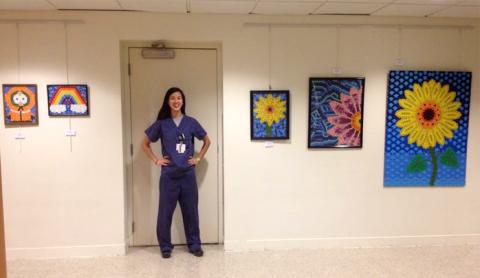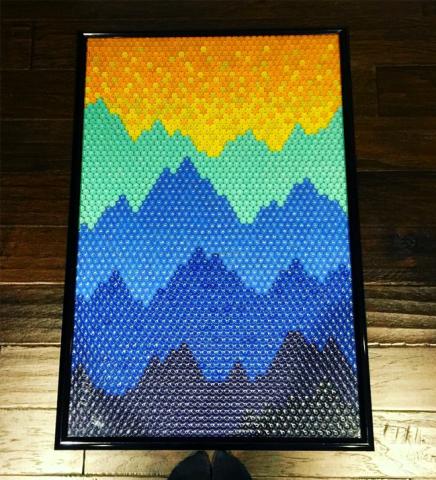Angela Hovis ('11) had longed to work in healthcare since she was a teenager. Driven by that passion, she attended Case Western Reserve University and stumbled across the MSA Program. She fell in love with the anesthesia field and enrolled in the program as soon as possible.
Hovis couldn’t help but express how grateful she is to have been able to attend CWRU and be a part of this amazing program. Now, she strives to give back to the field that gives her so much. She works as an instructor and healthcare provider and has helped implement the CAA programs in both Houston and Denver.
When did you decide that you wanted to work in healthcare?
It was in high school. There wasn’t necessarily one factor that drove me towards it, or a moment of realization. I always knew, and it was always driven into me, that I was going to work in the medical field someday.
What drew you to Case Western Reserve University’s MSA Program?
I was already an undergraduate student at CWRU. The summer before my sophomore year, I was searching for on-campus jobs and I found one in the MSA office. I did administrative assistant work in the office. At the time, I had to enter evaluations into the computer by hand. That’s how I learned about the program.
What types of clinical rotations did you complete?
The variety is amazing. I did cardiac, pediatric, neuro, trauma, ICU, ambulatory, and obstetric medical rotations. The work is always fresh and exciting because you’re never doing the same thing twice. I would be in pediatrics one day and then working open heart surgery the next. I can’t get tired of the job because it’s always changing.
Do you feel that the program helped you to be a compassionate caregiver?
Oh, most definitely, especially when it came to my instructors at University Hospitals. They were always very compassionate as teachers and health care providers. Seeing that in action, I knew that I wanted to do the same thing. I wanted to incorporate that compassion and empathy into my own practice.
What is a typical “day in the life” where you’re currently working?
I currently work in Denver, mostly doing outpatient work. We do pre-op with the patient in the morning. If they’re nervous or worried, I do my best to help calm their nerves and reassure them. I talk to the anesthesiologist and figure out what our plan of action is. I usually have a student with me so I also try to get them involved. First, I determine how far along the student is and how many times they’ve been in the operating room. After that, I can determine how involved and hands on they should be.
I love that I’m able to teach and train students. It’s a way for me to give back to a profession that I receive so much from. I’m able to apply all the great things I learned from my instructors.
What advice would you give to a future student of the program?
The program can be frustrating at times. You learn to do anesthesia in a lot of different ways. It can be a mystery as to what’s going to be thrown at you or what might change when you’re in the OR, so you have to be flexible and prepared for anything. A student might learn how to do “Plan A” but then they tell you that they need you to do “Plan B.” Try not to take that kind of thing personally. It’s never personal or because your teacher doesn’t like you or something. They’re training you to have that flexibility and to be able to switch tactics on a dime if need be.
Students tend to get frustrated because they may learn one way, but then their clinical instructor for the day doesn’t want them to do it that way. So, students have to take everything in stride, learn the new way your clinical instructor is teaching you, and then add it to your basket of knowledge and methods.
Do you have any hobbies? What do you do in your free time?
Living in Colorado, I’m in this amazing adventure state. I ski, run, bike, and rock climb (indoor and outdoor), all sorts of fun things. In addition to that, I make art out of old drug bottle caps. I’ve been collecting caps since I was a student myself; so probably for about 7 or 8 years. When I get a good pile of caps, I try to make something nice out of them. I’ll get a flat piece of wood or other material and recycle it by using it as my base. I was even able to use an old door that no one wanted anymore as one of my bases. Then I glue the caps to it and assemble it into an image. There are so many colors of caps that it works really well!
My coworkers and students know that I make art and they’ll collect caps for me as well. I can’t tell you how many times I’ve walked past a student and they turn to me and say, “Oh! I have drug caps to give you!” Then they’re always really excited to see what I’m able to make out of them. It’s very sweet. (More pictures at the end of the article.)
Is there anything else you’d like to add?
My experience at CWRU was amazing. I was at Cleveland for my undergrad, and started working for CWRU in Houston immediately after graduation. I worked there for three and a half years and was involved in working with the MSA Program. It was a newer program in Houston, but I was able to take things I had seen and learned in Cleveland and apply them to Houston’s program. Then I moved to Denver and was able to do the same thing all over again.
The program has continued to grow and change and I’ve been able to help implement more of CWRU’s methods and ideas. We’ve been revamping the industry, and it’s yet another way I can give back to the program and profession I love.
I was very privileged that I was able to attend this program at CWRU and work with amazing people. I have been surrounded by so many supportive people who wanted me to succeed. I’m very grateful that I was able to go to CWRU. And now I get to help other people learn and enjoy the profession as much as I do.
Browse the gallery below to some of Angela's creations.





